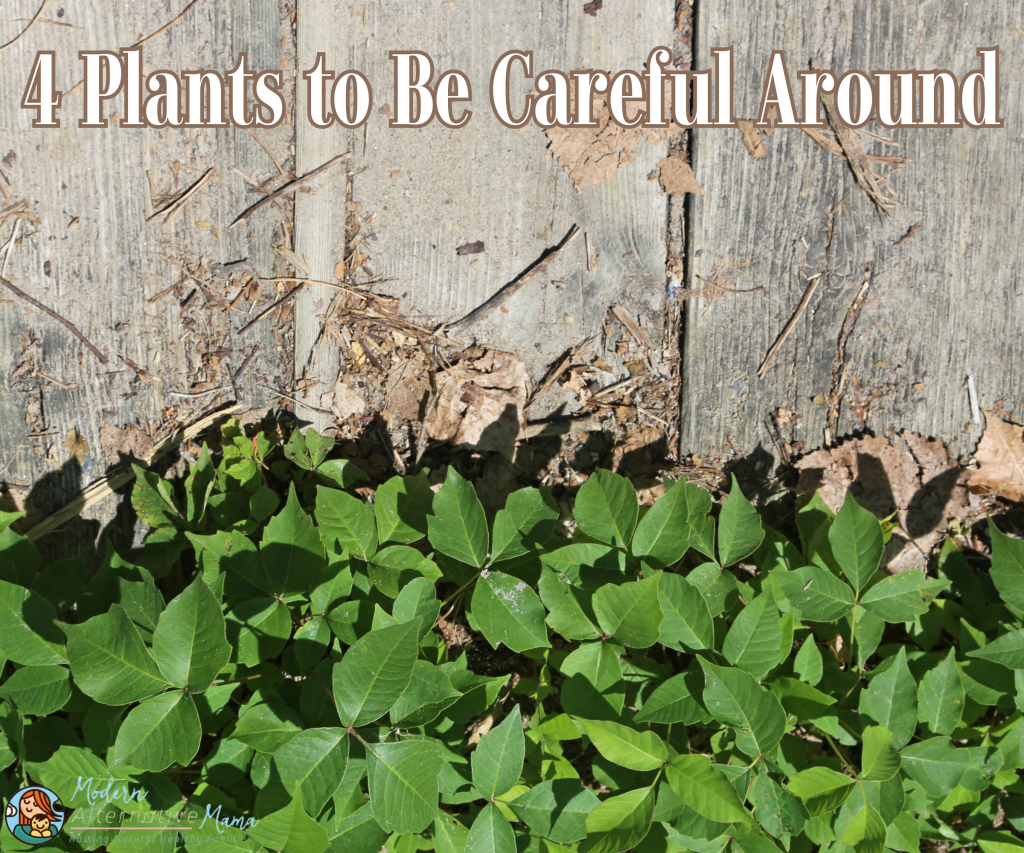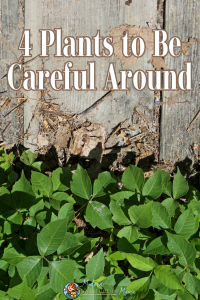Growing up in the late 90s early 2000s, I played outside, A LOT! I loved exploring the woods, playing in the dirt, and nature. I loved finding fungi and bringing them to school to show my science teachers and try to identify what was growing in my backyard.
Unfortunately, no one ever taught me what plants to be careful around.
So, of course, every summer, I got the worst possible case of poison ivy, oak, or sumac. I typically got it towards the end of summer, and when September rolled around and school started back up, the school nurse always sent me home until the rash cleared. One year, it was so bad the rash made its way to my eyes, mouth, and genitals – it was dreadful, to say the least.
Today, I want to share some tips on plants to be careful around to spare children from the misery I always endured.
#1 Poison Hemlock
I don’t think I’ve ever encountered poison hemlock, but that doesn’t mean we shouldn’t know about it. Poison hemlock is found on roadsides, edges of cultivated fields, creekbeds and irrigation ditches, and waste areas. Poison hemlock is toxic and can poison domestic animals and humans when consumed, even in small amounts (1).
Unlike the other plants in this article, touching poison hemlock is usually safe. Those with sensitive skin may experience dermatitis. In rare instances, hemlock poisoning can occur after toxins enter your bloodstream through a cut, eyes, or nose. Hemlock poisoning typically arises within minutes to hours after ingestion, and symptoms can range from vomiting to seizures to respiratory failure and even death (2).
Furthermore, poison hemlock may be mistaken for wild carrot, parsnip, or parsley. Poison hemlock can be identified by its bright green leaves that are fern-like and toothed on the edges. When crushed, the leaves have a strong, musty odor. Poison hemlock’s stems are hairless and hollow with reddish or purple spots and streaks. Often attached to the ends of the stems are small, white umbrella-shaped flower clusters (3).
#2 Poison Ivy
Who heard the phrase “leaves of three, let it be” growing up? Maybe my parents missed the memo because I didn’t hear the phrase until much later in life, but I sure wish I had heard it sooner!
Poison ivy is found throughout the United States except in Alaska, Hawaii, and parts of the West Coast. Poison ivy can grow as a vine or small shrub trailing along the ground or climbing on low plants, trees, and poles (4).
Contact with poison ivy may result in a rash due to an allergic reaction to the urushiol resin. Reactions to poison ivy typically manifest within 12-48 hours after exposure. A poison ivy rash typically appears in a straight line with accompanying symptoms such as redness, itching, swelling, and blisters. If you inhale the smoke from a burning poison ivy plant, you may experience difficulty breathing (5). Not everyone is allergic to poison ivy, so not everyone will react to its exposure.
Contrary to popular belief, poison ivy does not spread and is not contagious. The rash will only occur where the plant’s oil has touched the skin, so a person with poison ivy can’t spread it on the body by scratching.
Furthermore, poison ivy may be mistaken for aromatic sumac (skunkbush), Virginia creeper, and boxelder (6). Poison ivy can be identified by its compound leaves with three leaflets with smooth or coarsely toothed edges. All leaflets have their own stalks, and their surface can be glossy or dull. The middle leaflet is attached to a much longer stalk, while the two on the side are much shorter (7).
#3 Poison Oak
Poison oak is a lot like poison ivy, and the same rules apply – leaves of three, let it be! Poison oak grows as a low shrub in the Eastern and Southern United States and tall clumps or long vines on the Pacific Coast (4).
Like poison ivy, contact with poison oak may result in a rash due to an allergic reaction to the urushiol resin. Again, not everyone is allergic to poison oak, so not everyone will react to contact exposure. Reactions to poison oak are the same as poison ivy and typically manifest within 12-48 hours after exposure. Common symptoms of a poison ivy rash include redness, itching, swelling, and blisters, usually in a straight line. If you inhale the smoke from a burning poison ivy plant, you may experience difficulty breathing (5,8).
Like poison ivy, poison oak does not spread and is not contagious. The rash will only occur where the plant’s oil has touched the skin, so a person with a rash can’t spread it by scratching.
Furthermore, poison oak, like poison ivy, may be mistaken for aromatic sumac (skunkbush), Virginia creeper, and boxelder (9). Poison oak can be identified by its dull green compound leaves with three leaflets that are more lobed or toothed than poison ivy. Poison oak leaflets have their own stalks, but unlike poison ivy, they have hairs on both sides, and the tips are rounded. Like poison ivy, the middle leaflet is attached to a much longer stalk (but shorter than poison ivy), while the two on the side are much shorter. Additionally, poison oak may bear greyish-white colored fruit, which isn’t safe to consume (10).
#4 Poison Sumac
Poison sumac is found mostly on the eastern side of the United States. It tends to grow in wet areas like swamps. Contact with poison sumac may result in a rash due to an allergic reaction to urushiol resin. Not everyone is allergic to poison sumac, so not everyone will react to contact exposure (11).
Reactions to poison sumac are the same as poison ivy and oak and typically manifest within 12-48 hours after exposure. Common symptoms of a poison sumac rash include redness, itching, swelling, and blisters, usually in a straight line. If you inhale the smoke from a burning poison ivy plant, you may experience difficulty breathing (5,8,11).
Furthermore, poison sumac may be mistaken for smooth sumac (Rhus glabra), staghorn sumac (Rhus typhina), and dwarf sumac (Rhus copallinum) (12). Poison sumac can be identified by its leaves that grow in groups of 7 to 13 oval leaflets. Poison sumac leaflets have smooth edges and are connected to red stems. The plant’s bark is smooth and gray-colored. Poison sumac grows as a shrub or small tree with yellow-green flowers that bloom into glossy, drooping pale-yellow or cream-colored berries (13).
The best remedy is prevention, so I recommend pouring some vinegar on these plants if they grow in your backyard. If you encounter any plants that cause topical reactions, I recommend checking out our blog, 6 Must-Have Natural Remedies for Summer, for some effective natural remedies (it even mentions an anti-itch soap).







